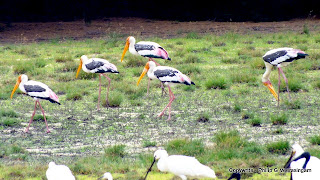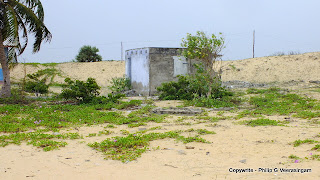Tuesday, February 5, 2013
Monday, February 4, 2013
Bird life among the sand dunes of Manalkaadu, Point-Pedro, Sri Lanka.
 |
| A fresh-water collection among the sand dunes. |
 |
| An Open-Bill contemplating the camera-man. |
 |
| Collections of birds feeding in a pond. |
Time has stood still among these shifting sands. The birds in their variety come to feed, build their nests and breed. They raise up their young and depart. They are the wanderers but return home every year. What a contrast they are to humans, ever in search of better pastures. The latter hardly seem to realize that your home is where your heart is.
To watch a video of some bird life click on the web-link below:-
http://www.youtube.com/watch?v=Ben1xU2fU-A
Sunday, February 3, 2013
Manalkaadu, Point-Pedro, effects of the Tsunami.
 |
| Abandoned house and well. |
 |
| Effects of the Tsunami on a prosperous house near the sea-shore. |
 |
| New houses and settlements two Kilometers from the shore. |
 |
| The cemetery where the dead of the Tsunami were buried. |
‘Home
was home then, my dear, full of kindly faces,
Home was home then, my dear, happy for the child.
Fire and the windows bright glittered on the moorland;
Song, tuneful song, built a palace in the wild.
Now, when day dawns on the brow of the moorland,
Lone stands the house, and the chimney-stone is cold.
Lone let it stand, now the friends are all departed,
The kind hearts, the true hearts, that loved the place of old’.
Home was home then, my dear, happy for the child.
Fire and the windows bright glittered on the moorland;
Song, tuneful song, built a palace in the wild.
Now, when day dawns on the brow of the moorland,
Lone stands the house, and the chimney-stone is cold.
Lone let it stand, now the friends are all departed,
The kind hearts, the true hearts, that loved the place of old’.
‘Home No More Home To Me, Whither Must I Wander?’
by Robert Louis Stevenson
Saturday, February 2, 2013
Manalkaadu beach, Sri Lanka.
 |
| Houses destroyed by the Tsunami. |
 |
| New buildings close to the beach. |
The fury of the Tsunami which wiped out the residents close to the beach. Similar occurrences are recorded in tales and legends going back more than two millenia. The shorelines facing the eastern parts of the Island and of the Indian sub-continent have these tales. Prosperous trade emporia like Vallipuram in Sri Lanka and Kaverippooom Pattinam in South India were wiped out in a matter of minutes. Indra was the God of the Oceans and the destruction of Kaverippoom Pattinum in South India was attributed by the populace, to a failure to hold the annual festivities - called Indra Villaa - to this God. This is related in the Tamil Buddhist epic 'Manimekalai' written about the 2nd Century AD.
Friday, February 1, 2013
Thursday, January 31, 2013
Vallipuram - Manalkaadu, Point-Pedro, Sri Lanka, birds
 |
| A varied collection of birds. |
 |
| Ibises in flight. |
 |
| Black-winged Stilt. |
 |
| Painted-Storks. |
Video:-
http://www.youtube.com/watch?v=Ben1xU2fU-A
Wednesday, January 30, 2013
Vallipuram Temple, Point-Pedro, Sri Lanka.
 |
| 'Pura-veedhi' - outer road surrounding the Vallipuram Temple. |
 |
| Palmyra tree with branches. |
 |
| Open-bill feeding. |
http://www.youtube.com/watch?v=VNWMM8IM16A
 |
| Egret and a Black-headed Ibis feeding in a paddy field. |
Subscribe to:
Posts (Atom)











